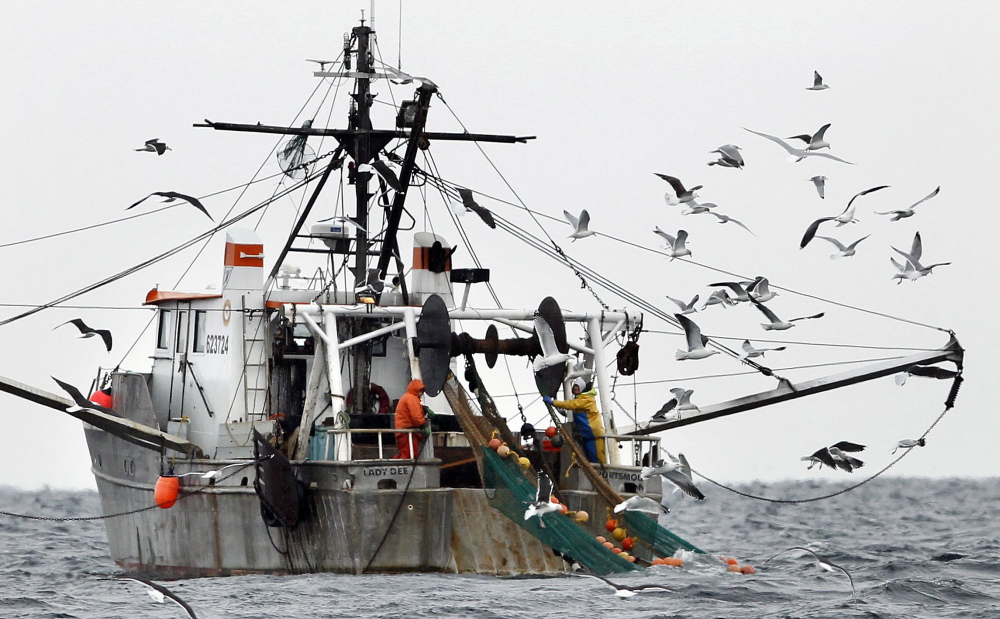Maine fishmonger Glen Libby made a disheartening discovery at Easter Sunday brunch – the cold-water shrimp on the menu at a restaurant up the street from his fish market were from Canada, not New England.
Canadian imports of the sweet, quarter-sized crustaceans are turning up more in American restaurants and seafood markets since a ban on fishing for Maine shrimp dried up local sources. The value of Canada’s shrimp imports to the U.S. grew nearly 20 percent, to more than $30.5 million, from 2013 to 2014, federal statistics say. Canadian imports of cold-water shrimp to Maine alone more than doubled, to nearly 100 metric tons, in that time, Canadian authorities said.
The price to American consumers has also risen since the December 2013 shutdown. Libby said the inability to sell the popular shrimp is a deep pain in the winter and spring, when customers typically come looking for them. But he said he’d rather wait for the American fishery to reopen than sell the Canadian alternative.
“We’re trying to be about local food, so that doesn’t really fit the model,” Libby said. “We’re selling what’s available and what’s in season.”
Fishermen from coastal New England and eastern Canada fish for the pinkish cold-water shrimp, which are popular for their tender meat. Regulators shut down the Gulf of Maine fishery, which was dominated by Maine fishermen and also included some from New Hampshire and Massachusetts, over concerns about low population. Scientists have cited rising temperatures in the Gulf of Maine as a threat to the species, which many Maine fishermen rely on to make money during the winter.
The Canadian fishery for the shrimp is much larger – and according to Canadian authorities, more stable – than New England’s. Canadian fishermen’s catch of the shrimp averaged about 150,000 metric tons per year from 2009 to 2013. New England’s catch averaged about 3,300 metric tons in that time, including a low year of about 300 metric tons in 2013.
Canadian shrimp landings are above average over the last 15 years, said David Walters, a spokesman for Fisheries and Oceans Canada. He said shrimp stocks are down in the southern end of their range, off Newfoundland and Labrador, where much of the fishing takes place, but they remain in “good condition.”
Meanwhile, some Maine dealers said they or other vendors have resorted to Canadian alternatives so they can keep the popular item on the menu. Libby’s brother Gary, a fisherman who sits on the multistate Northern Shrimp Advisory Panel, said the Canadian shrimp are “filling in for now” until the New England stock rebuilds.
Gary Libby predicted that the presence of Canadian shrimp on the market could ultimately benefit Maine shrimpers because it will keep consumers familiar with the product, which is smaller and sweeter than the familiar warm-water shrimp of the Gulf of Mexico.
“Once we get our resource back, we’re going to own it because we’re going to be able to deliver the product for less than Canada can,” Gary Libby said.
The lack of availability of cold-water shrimp also has made them more expensive. The shrimp often cost consumers $10 or more per pound – more than three times the typical price three years ago.
Maine Department of Marine Resource Commissioner Patrick Keliher is not concerned with the impact of Canadian imports, in part because consumers will “recognize the superior value of Maine shrimp when they once again have access to it,” a department spokesman said. Maine’s shrimp are typically a little meatier than their Canadian cousins, fishermen said.
Spencer Fuller, a shrimp and lobster buyer at Cozy Harbor Seafood in Portland, said he hopes the ban on fishing Maine shrimp is lifted next winter.
“We really need this fishery back in this state,” he said.
Send questions/comments to the editors.



Success. Please wait for the page to reload. If the page does not reload within 5 seconds, please refresh the page.
Enter your email and password to access comments.
Hi, to comment on stories you must . This profile is in addition to your subscription and website login.
Already have a commenting profile? .
Invalid username/password.
Please check your email to confirm and complete your registration.
Only subscribers are eligible to post comments. Please subscribe or login first for digital access. Here’s why.
Use the form below to reset your password. When you've submitted your account email, we will send an email with a reset code.